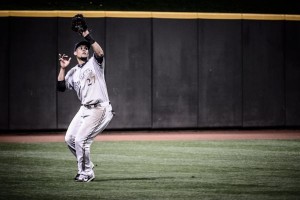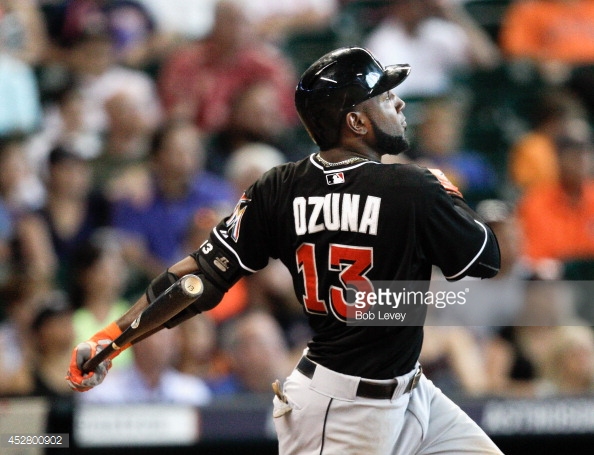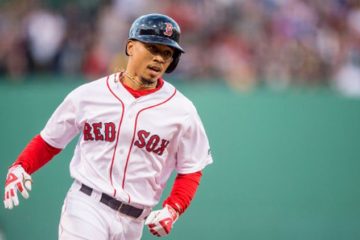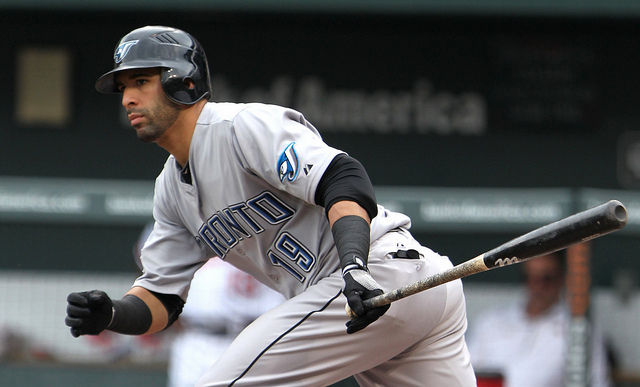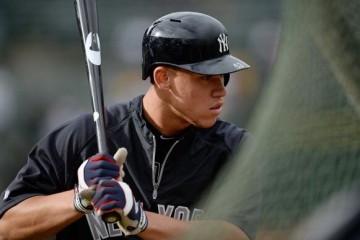2013 Fantasy Baseball Outfield Rankings: A Look at #3 Outfielders
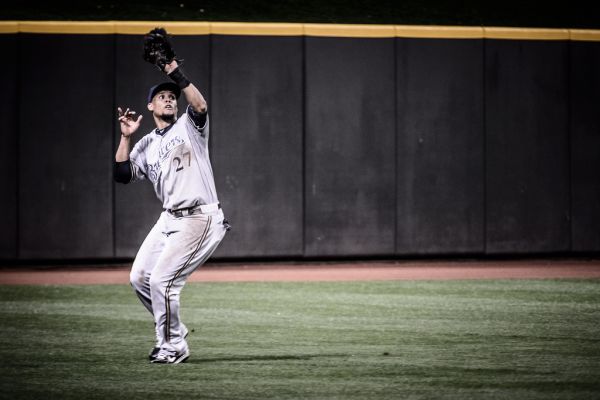
Over the next week or so we will be releasing teasers of our staff consensus rankings with the hopes that you will break the bank and purchase our 2013 Fantasy Baseball Draft Kit to see the full versions, and more importantly, show us your support.
Thanks in advance.
Here are the outfielders we have ranked 21-30, all guys who will be drafted in even the shallowest of ten team, three outfielder leagues.
21. Shin-Soo Choo | OF | CIN
When Choo became a regular in late 2008, he displayed the potential to be a 20/20 guy. And that’s exactly what he did the next two years. But in the last two seasons he has failed to make it to 20/20. Injury prevented him from getting there in 2011, but he wasn’t on pace to get to 20 homers anyway. He only hit 16 homers last year, although he did steal 21 bags.
The homers have gone away because of a shift in Choo’s batted ball profile. His fly ball percentage has dropped in each of the last three years and is down about 9% from where it was in 2009. Fewer fly balls and more ground balls isn’t the worst thing in the world for Choo’s batting average given his speed. But Choo is 30 now, so the speed could start to decline. If that’s the case, the BABIP, and thus the batting average, will dip as well.
Maybe the biggest concern with Choo is that his ability to hit lefties absolutely tanked last year. As a lefty hitter, he’s always been much better against righties, but he was at least close to average against lefties prior to last year. But last year he managed just a .282 wOBA and 78 wRC+ against lefties.
The move to a much more hitter-friendly ballpark in Cincinnati could mitigate some of the potential decline. He can probably hit 16+ home runs again even if his fly ball rate continues to decline. And there’s no reason to expect his abnormally high BABIP to fall off the map. But his age and the trend of his batted balls are somewhat of a concern. So he’s a nice option that will help across multiple categories, but there’s almost no upside here.
22. Austin Jackson | OF | DET
Let’s start with the good. Jackson has really improved his discipline at the plate. He was much more selective last year, swinging at fewer pitches both inside and outside of the zone (but more so at those outside of the zone). He also made more contact. All that led to a significant drop in his K% from 27.1% to 21.7% and a 2.5% jump in his BB%. With that level of plate discipline and the potential that it could continue to improve, Jackson is no longer much of a batting average risk. With his old 27% K%, Jackson hit just .249 when his BABIP was a low-for-Jackson .340. But with a K% of 21%, Jackson hit the .300 mark with a BABIP almost identical to his career mark.
Now the bad news. Jackson may not be the 20+ steal guy we all thought he was going to be when he came up. His steal totals have declined in each of the last two seasons, and he stole just 12 bases last year. Even more concerning, Jackson was caught stealing nine times for a success rate of just 57%. And Jackson may be more of a low-teens homer guy as opposed to the 16 homer guy he was last year because he’s probably due for a bit of regression with his HR/FB rate.
So Jackson may not be the good player in the way we all thought he might be a few years ago. But he’s still a good player.
23. Alex Gordon | OF | KC
Trying to project Gordon feels a lot like trying to project Choo. They’re both high BABIP guys who need to keep the BABIP around .350 to keep the batting average in the .280-.300 range. And Gordon should be able to sustain that BABIP given his established ability to hit a lot of line drives. They also have very similar strikeout-to-walk skills, and they both provide more runs than RBI.
Where they differ is the power and speed departments. Gordon has a little more pop, and Choo has a little more speed. Gordon is a touch younger and may be in line for some positive regression with his HR/FB rate, so he has more upside than Choo. We still prefer Choo because we feel he has a higher floor, but it’s totally understandable if you prefer Gordon here.
24. Desmond Jennings | OF | TB
Jennings racked up 85 runs last year in just 132 games. If he can get to 150+, he should approach the century mark. And he’s a safe bet for 30+ steals. He got 31 last year and was only caught twice, so the speed is legit. There’s 40 steal-upside there. Throw in at least a homer total in the low teens with a little bit of upside there, and Jennings is a real contributor in three categories.
The problem is the batting average. He doesn’t strike out a ton, but at 20%+ Jennings needs some BABIP help to get his average up over .260. Unfortunately, he plays in one the five most hit-depressing ballparks in the league (per ESPN’s park factors). As such, you just have to assume Jennings is going to ding your batting average some. But if you don’t take any batting average risks early, Jennings would be a nice guy to add in the middle rounds. But if you take a guy like Jay Bruce or Curtis Granderson early, Jennings might not be your guy.
25. Carlos Beltran | OF | STL
Beltran has had quite the renaissance. He posted a stellar .391 wOBA in 2011 (13th best in the league) and followed it up with a 32-homer campaign last year. The problem is that the 32 homers were achieved by a more aggressive approach, which might not be sustainable. Beltran swung more and made less contact, an obvious sign that he was “going for it” more often. Unfortunately, he won’t be able to repeat his 20% HR/FB rate, so if that approach continues, Beltran becomes a batting average risk. You’ll take a .270 or lower average if 32 homers come with it, but it’s just not as attractive with say 20 homers. Throw in a max of about ten steals and some risk that inherently goes with a 36-year old player and Beltran may be a bit over valued this year.
26. Shane Victorino | OF | BOS
If you aren’t a Victorino fan, it’s probably because you don’t like his batting average and/or you don’t believe he can approach 40 steals again. As for the batting average, Victorino just doesn’t hit enough line drives to sustain a high BABIP. But his new home park is the second most hit-friendly park in the league. He’s not going to hit .300 or anything, but it wouldn’t be a stretch for him to get back to the .280-.290 range.
As for the steals, new Red Sox manager John Farrell seems like he likes to run. As manager of the Blue Jays last year, the Blue Jays attempted a steal once every 13 opportunities which was the sixth highest rate in the league. In 2011 the Jays attempted a steal once every 12 opportunities (also the 6th highest rate in the league). Given that information and the likelihood that Fenway could help Victorino reach base more often, it’s not unreasonable to think Victorino could approach 40 steals again.
27. Carl Crawford | OF | LAD
Let’s just ignore 2012. Let’s figure out what happened in 2011. The phrase “trying to do too much” was thrown out quite a bit while Crawford struggled in Boston. And that narrative may be borne out somewhat in the stats. Crawford swung at a significantly higher percentage of balls outside of the zone and a lower percentage of balls in the zone than he had in previous years. Hacking at pitches outside the zone more often certainly seems to fit the narrative of “trying too hard.”
As a result of this decrease in plate discipline, Crawford’s BABIP was about 30 points lower than his career average, and he posted the lowest batting average of his career. The big concern is that this downward trend in plate discipline actually started in 2010 and just worsened in 2011. Maybe the pressure is lessened being on a new team. Or maybe the pressure is just as present because he’s on a new team. Who knows? There’s certainly upside, but there’s just as much, if not more, risk.
28. Carlos Gomez | OF | MIL
It’s not often you see a player coming off a season with 19 homers and 37 steals with an average draft position of 200+, especially when that player compiled those stats in just 452 plate appearances. But that’s the situation we have with Gomez this year.
Before we address the sustainability of the roto numbers, we should project plate appearances. The bench outfielders currently behind, Gomez, Norichika Aoki and Ryan Braun are Taylor Green and Logan Schafer (who?), so Gomez figures to be a regular while Corey Hart is out. Even when Hart returns, Gomez may keep his regular role because Hart played two-thirds of his games at first base last year. What it may depend on is how Mat Gamel plays in Hart’s stead. If Gamel forces his way into regular playing time, Gomez could lose some at-bats at the expense of Hart playing in the outfield. But Gamel is anything but a sure thing to play his way into regular at-bats.
OK, now let’s discuss the likelihood that Gomez can repeat those roto numbers. The most repeatable of his numbers is steals. Gomez has an 88% success rate over the last three seasons (71 for 82), so the Brewers should let him keep running. If they do, he’ll top 30 again and could get to 40 depending on playing time.
The home runs are a bigger question. Gomez posted a career high HR/FB rate last year, but it wasn’t too far out of line with what he did in 2011. And in 2011 his batted ball profile shifted towards more fly balls, which continued last year. So before you assume much HR/FB regression, consider the fact that there is evidence that Gomez has added an upward element to his swing.
Unfortunately, those extra fly balls hurt his batting average. The more balls Gomez hits in the air, the fewer opportunities he has to use his speed to leg out hits. If he keeps his GB/FB around 1.00, you can expect a similar home run output with .240-.260 average. But the higher his GB/FB gets above 1.00 the more average potential he has. Gomez just doesn’t have the strikeout and walk skills to maintain both the power and a high batting average, so expect some trade-off between those two numbers.
29. Josh Willingham | OF | MIN
There’s not a ton to say about Willingham. He has identical BABIPs of .287 in the last two seasons with averages of .246 and .260 that are tied to how disciplined he is at the plate. He’s a safe bet to hit around 30 home runs, although a touch under 30 might be a more reasonable expectation than the 35 he hit last year because he should see a bit of regression in his HR/FB rate. No speed, a healthy RBI total with an at least decent amount of runs rounds out the profile for the Twin. If you feel like you missed out on power early, Willingham is an excellent option for you in the middle rounds.
30. Martin Prado | OF | ARI
This ranking might be a bit low for a player with dual eligibility who can hit for average, has double digit homer and steal potential and who will be a decent contributor in runs and RBI as well. Maybe our rankers (myself included) were still scared off somewhat by the .260 average in 2011. But that’s explained away by the bizarrely low LD% that Prado had that year. The 14.8% LD% was six points lower than his rate in 2010 and over eight points lower than his rate last year. So if you think there’s batting average risk, there really isn’t.
You can follow Brett on Twitter @TheRealTAL.
As always, thanks to Fangraphs.com and baseball-reference.com for all the data.


